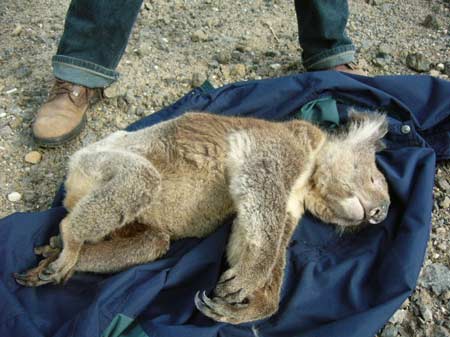

The first time it happened, Debbie Birkett couldn't go through with her plan to snip the ears off the koala lying dead on the road.
She thought she had mentally prepared for the moment but lost the nerve, wrapped the carcass in a towel and took it home. Her partner reluctantly performed the gruesome deed.
That was five weeks and three dead koalas ago. Now she approaches local roadkill with a scientific steeliness; snipping, recording and removing the remains.
Ms Birkett has joined a small group of committed "roadkill clippers" on a quest to prove that koalas inhabiting the Strzelecki Ranges close to her Leongatha home are not your average marsupials and deserve protection.
The nation mourned the death in August of bushfire mascot Sam the Koala, but behind the feel-good images there lies a story of hard-headed politics, multimillion-dollar timber contracts and the survival of what may be Victoria's last genetically pure population of koalas.
Koalas were declared extinct on the Victorian mainland in 1948 after being decimated by fur traders and bushfires. The koalas we now have are the offspring of a handful of animals relocated to French and Kangaroo islands about 100 years ago.
But in the 1990s, after studying a cross-section of Victorian koalas, geneticist Dr Bronwyn Houlden found the Strzelecki koala was genetically different, perhaps a remnant of the population that ranged across Victoria and South Australia before white settlement.
Sam the Koala was one of them.
The Australian Koala Foundation believes these South Gippsland koalas may hold the key to the survival of koalas across southern Australia. But without an audit of their numbers and solid DNA evidence, scientists and wildlife conservationists are unable to mount a case that the Strzelecki koala should be given protected species status.
So, in an extraordinary example of community activism, locals have spent the past eight years snipping the ears off roadkill and storing them in freezers and jars of methylated spirits to gain enough data for DNA analysis.
The results of those tests, conducted by PhD student Tristan Lee at the University of Sydney, are expected before Christmas.
"It may be that [the Strzelecki koala] is the last remnant of Victorian koalas before they got a bit inbred on [French and Kangaroo] islands," said Mr Lee. "They could be a reservoir of unique genetic variation with implications for the whole Australian koala population and, if so, could make a strong arguement for habitat preservation."
Leading koala expert Dr Steve Phillips believes the failure of the State Government to fund a Strzelecki audit is typical of a tendency in Victoria to "treat koalas fairly dismissively".
"One of the problems is apathy and what seems to be a reluctance to acknowledge that this is a very important population," said Dr Phillips.
"Through a long history of koala management in Victoria there is a tendency to say 'not another bloody koala problem'.
"There are mechanisms in the Victorian Flora and Fauna Guarantee Act to get the koalas nominated but to support that we have to know how many there are and where they are."
Dr Phillips said the Black Saturday fires had given the matter greater urgency. " A population that was in trouble may now be endangered," he said.
COPY OF FOLLOW UP LETTER, SUNDAY AGE REFUSED TO RUN 15 NOVEMBER 2009
Strzelecki Koalas Got 'Jeffed'
Following on from Carmel Egans' article 8/11/09, regarding the desperate plight of the Strzelecki Koala, few people realise that almost all of the Strzelecki Koalas' habitat is in foreign hands. The vast majority of the habitat was sold by the Kennett Government in 1998 to Hancock Victorian Plantations. Since the sale, almost 8000 hectares of koala habitat has been clearfelled and replanted with Shining Gum, a species not eaten by koalas. 80% of the clearfelled Mountain Ash and native forest has ended up at the now Japanese owned Maryvale Pulp Mill to be turned into photocopy paper. On top of this, several thousand hectares of prime Koala habitat including thousands of koalas were incinerated in the Churchill February 2009 bushfires. What chance does Victorian wildlife have against the rapacious appetite of the paper industry? Why is there no management strategies by Hancock or the State Government to protect the Strzelecki Koala?
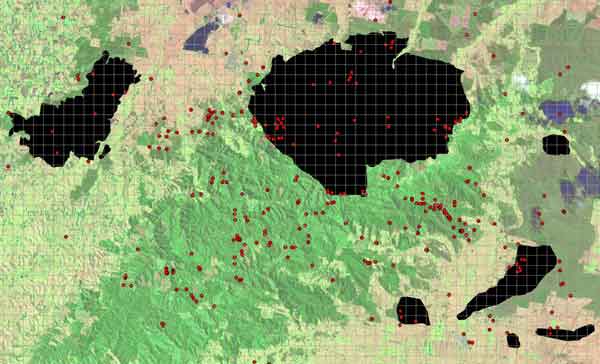
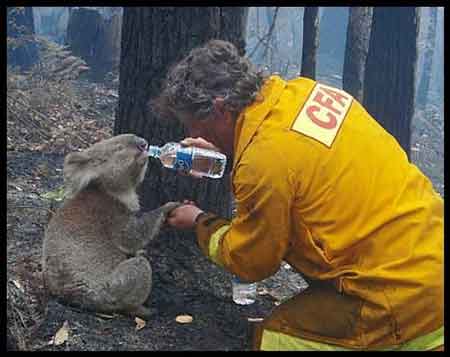
Mirboo North Koala "Sammy" with burnt paws during CFA burnoff. Sammy made global news (she died of Chylamidia August 6 2009).
***Press Release 11/10/09*** Let the Death of 'Sam the Koala' not be in Vain.
The unfortunate death of 'Sam the Koala' made media headlines last week with laments coming far and wide, nationally and internationally. There is no doubt that the filming of Sam drinking from a water bottle after being burnt, was a very powerful media image, but has anyone really given much attention to the long term plight of Sam and similar bushfire survivors? What chance did Sam really have in the long term? It's well and good to get emotional about Sam, but what about the hundreds of other koalas, like Sam who also face an uncertain future and who also suffered horrendously in the fires?
Sam was a Strzelecki Koala, the only genetically pure koala population left in Victoria and South Australia. The Strzelecki Koalas hold the key for the preservation of the species throughout Victoria and South Australia. All other Koala populations in Victoria and South Australia suffer from diseases caused by inbreeding as they are the desecendents of only 4 animals transferred to French Island in the 1890's.
The Strzelecki Koalas, and Victorian Koalas as a whole, are under dire threat because of habitat destruction. Nothing is being done to protect this species. There is no EFFECTIVE legal protection for the koala and it is not listed as endangered or threatened. Likewise there is no legislation to protect koala habitat. In fact the best of the remaining Strzelecki habitat is being logged at a rate of 700 hectares per year by Hancock Victorian Plantations (HVP), after they gained perpetual logging rights in 1998 via the sale of the Victorian Plantations Corporation by the Kennett Government. After logging 7000 hectares of koala habitat over the past decade, Hancock still don't have an adequate Koala Management Plan. HVP now control almost all of the Strzelecki Ranges.
Releasing Strzelecki Koalas into areas outside of the Strzeleckis will weaken the gene pool of the Strzelecki Koalas and place these individuals at risk. Diseases such as chylamidia, which eventually killed Sam, increase because of stress.
The January/February 2009 Delburn and Churchill fires burnt out approximately 50% of the best remaining koala habitat in the Strzelecki Ranges. Thousands of koalas most likely perished in the fires. Those lucky enough to survive now face the daunting prospect of having to survive in habitat lost through fires but also habitat loss through clearfell logging. Apart from small patches of bush in isolated private property where can the bushfire survivors, like Sam be released?
The land that Hancock purchased cannot be protected by government as it is covered by exemptions which allow the harvest of native vegetation, regenerating native forests, as well as 'plantations'. The Victorian Plantations Corporation Act overrides all other legislation. The land is deemed to be private land yet Local Government cannot stop Hancock logging koala habitat as there is no provision in the Planning Scheme to protect either the species or habitat.
Likewise both State and Federal Government's refuse to recognise processes that threaten this species. It is a disgrace that the Koala is recognised internationally but not nationally. The United States listed the Koala in 2000 under the US Endangered Species Act as threatened across its entire range. Yet nothing is done in Australia to protect the species. In two generations the Victorian Koala could be gone. The koala is also under threat from climate change, according to recent research by the University of Sydney, which shows rising carbon dioxide levels are killing nutrients in the plants they eat. The higher elevation forests, critical to the survival of the Koala is also under climate change threat, through decreased rainfall, increased likelihood of wildfires and logging its remaining habitat.
Let's not see Sam's death be in vain. Immediate action needs to be undertaken by all levels of Government to protect as much koala habitat as possibly immediately and both John Brumby and HVP need to get serious about forest protection in the Strzelecki Ranges.
More images of Strzelecki Koala Bushfire Survivors Here
Feb 12 2009: Another article here
"We do not have a Specific BMP for Koala's. Grand Ridge Plantations is currently working with the Australian Koala Foundation on a Koala Management Plan. This project is awaiting the completion of the current EVC mapping project in the Strzelecki ranges." Owen Trumper Manager Grand Ridge Plantations January 22, 2007.
Note: BMP refers to Best Management Practice
"Koala Bear* Management Plan Another comment from stakeholders was related to the Koala population in the Strzelecki. In respect of the Koala population, they represent a distinct population and would possibly be recognized as a distinct Management Unit (i.e. a distinct phylogenetic lineage). However in Victoria the Koala is not offered additional protection as a species let alone as distinct populations. As such HVP or any other forest manager for that matter is not required to establish specific management plans for this species. Smartwood however would like to suggest that in response to the stakeholders concerns HVP continue with the publication of the Koala Habitat Map#. If the Koala population requires conserving then it is the State Government's responsibility to list the species accordingly and this has not yet occurred. As such there is no specific reason why HVP as a private land manager should be required to establish conservation measures for a species such as the Koala as long as it is not required by the state or federal Government." Source: Page 7 Smartwood Forest Management 2008 Annual audit Report for Hancock Victorian Plantations Pty Ltd in Victoria, Australia. Authors: Christian Sloth/Roy Teale. Operation Contact: Malcolm Tonkin.
*The authors Smartwood don't appear to understand that koalas are not bears, they are marsupials.
#The Koala Habitat Project was announced by Hancock and Australia Koala Foundation (AKF) in October 2000. Nothing regarding this project has been sited publicly since that time. Meanwhile 700 hectares of prime koala habitat per year has been gutted by Hancock. 5600ha since the agreement was signed.
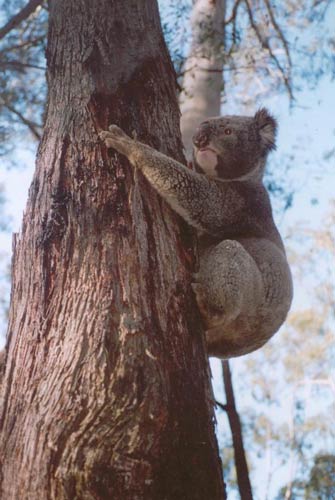
"FROM OUR CALCULATIONS, TO GRANT 150 HA OF SUITABLE HABITAT FOR EACH KOALA SITED WITHIN THE MOUNTAIN ASH REFORESTATION IN THE STRZELECKI RANGES SINCE 1990, A TOTAL OF APPROXIMATELY 12,960 HECTARES WOULD NEED TO BE SET ASIDE.
THIS WOULD REPRESENT APPROXIMATELY 70% OF THE HARDWOOD REFORESTATION/PLANTATIONS OF THE STRZELECKIS ESTABLISHED UP TO 1995." Anthony Amis Friends of the Earth August 2005.
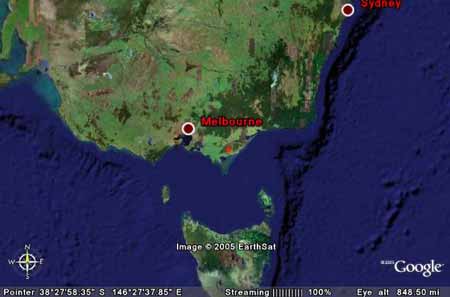
Approximate location of the Strzelecki Ranges in relation to Melbourne, the capital city of Victoria.
hancockwatch.nfshost.com
Very little is known about the Strzelecki Koala population. What is known however, is that it is one of the few (if not the only) truly endemic Victorian koala populations, with its gene pool currently uncompromised by the long-standing translocation program of the Victorian government. Because of this, the population is of considerable conservation importance, not just because of its uniqueness, but also because of its potential to assist longer term conservation and management efforts of Victorian koalas generally. In order to ensure than management of the Strzelecki Koalas is placed on a sustainable footing, research is needed into the following issues:
Priority 1: Preferred feed species - a peer reviewed methodology now exists (Phillips et al 2000; Phillips and Callaghan, 2000; Phillips 2000) by which food tree preferences can be quantified, thus allowing both planning and conservation decisions and/or actions to be implemented with greater confidence.
The Australia Koala Foundation (AKF) have undertaken some mapping work, but we have not seen the brief or the results. If management prescriptions are to be based on these recommendations then they need to be independently reviewed.
Priority 2: Location of breeding population(s) - a methodology has recently been developed (Phillips, pers. comm) that allows the boundaries of areas being utilised by breeding koala populations (as opposed to areas being utilised by transient koalas) to be accurately modelled and delineated for conservation and management purposes. Breeding patterns of Koalas are generally well understood and documented in the literature.
This is work that needs urgent priority. Again experienced people have offered to undertake the work and act as advisors to this project.
Long Term Project 2-5 year work
*Ph D student work. It has already been established that the Strzelecki Koala has rare alleles not found elsewhere in Victoria. Thus there is an urgent need to better understand the genetics of the Strzelecki Koalas and the geographical boundaries of the associated genome, in addition to quantifying levels of out (or in) breeding and movement patterns within the area using microsatellite DNA. Both the methodology and the infrastructure that would allow this work to proceed is already established (Phillips, per comm).
Priority 3: Assessing the impact of the fragmented nature of remaining habitat in the Strzelecki Ranges on the areas' Koala population is a long term project (10-20 years), as are the impacts of forest management practices.
Priority 4: Listing of the Strzelecki Koala under the Flora and Fauna Guarantee Act. This would be a unique project in that no population of a particular species has been listed in the FFG due to their uncompromised genetics and rare alleles. Listing the Koala would have large impacts especially in areas of State Forest that come under management of the Crown and are threatened by logging for firewood and pre-scribed burns.
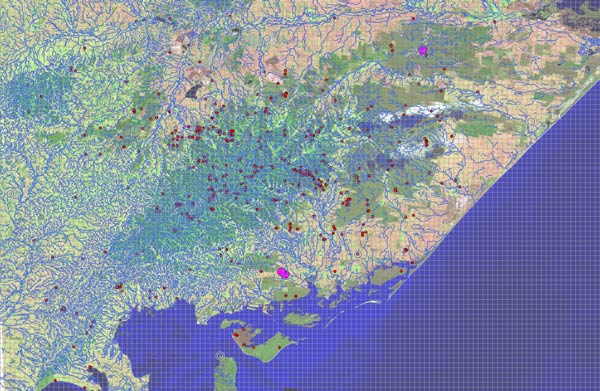
Over 350 Strzelecki and South Gippsland Koala sitings since 1990. The large pink dots represent koala translocation points. Koalas in the region stretch as far south as Wilsons Promontory and as far north as Morwell. Koalas at Wilsons Promontory and the translocated population on Snake Island have not been included in this study.
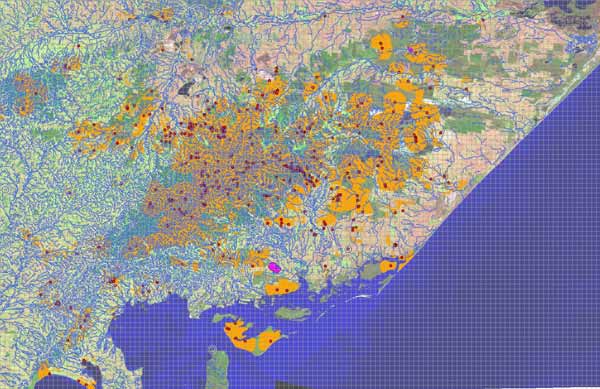
Strzelecki Koala map (see above and below) indicating highest densities of koala sitings since 1990. Koala sitings are shown in red. The gold shading represents 2km habitat range around each koala siting. This shading has led to the conclusions that koalas inhabit almost all of the Strzelecki Ranges, Mullundung and Wonwron State Forests. Numbers appear more limited on the coastal region of South Gippsland where habitat loss has most likely been a major factor in the Koalas decline. Pink circles represent koala translocation points. Numbers for Snake Island not accurately indicated in this study.

Strzelecki Koala map (see above and below) indicating highest densities of koala sitings since 1990. Koala sitings are shown in red. The gold shading represents 2km habitat range around each koala siting.
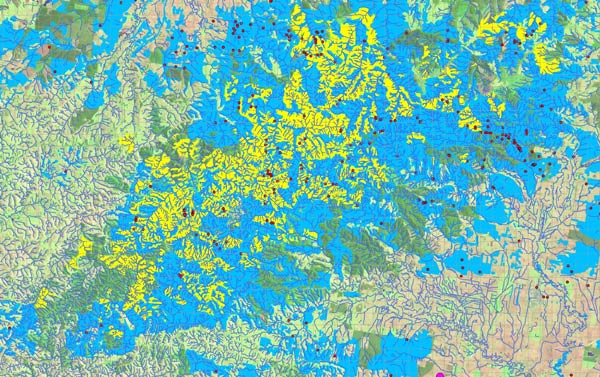
Blue indicates koala sitings with additional 2km habitat range per koala. Yellow indicates amount of habitat loss associated with logging activities of Mountain Ash forests of Grand Ridge Plantations. Between 25-30% of the Koalas habitat in the Strzelecki Ranges will be logged in the next few years. Almost all of these logging coupes will be replanted with Shining Gum, a non-endemic koala food tree. This is another disaster in the making for the Strzelecki Koala, with approximately 25% of koalas sited since 1990 being inside replanted Mt Ash sites. Between 600 & 800 hectares of Mountain Ash reforestation is being logged by Hancock in the region each year.
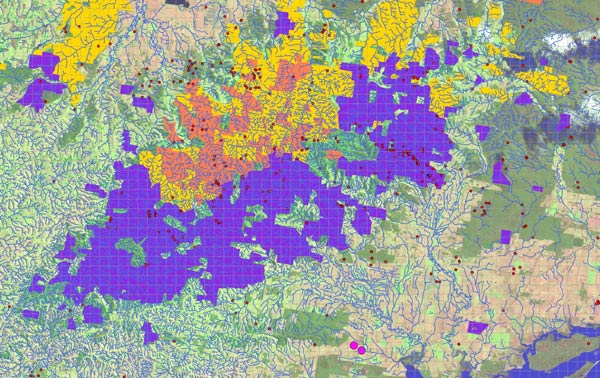
Shaded land represents land now under the control of Boston based Hancock Natural Resources Group, a subsidiary of John Hancock Financial Services. Purple represents 99 year lease hold (ex Victorian Plantations Corporation) purchased from the Victorian State Government in 1998, the pink represents leased Crown land under the 1961 and 1966 Wood Pulp Agreements (rights to log granted to Hancock in 2001), the gold represents private land purchased from Australian Paper Plantations in 2001. Approximately 54% of sitings for the Strzelecki and South Gippsland Koala since 1990 have been on land now managed by Hancock. Where is their Koala Management Plan?
In December 2004, Friends of the Earth was kindly granted funding to conduct a GIS mapping project regarding the plight of the Strzelecki Koala. This report presents its findings. FoE would like to thank the donors for their assistance, Susie Zent (Friends of Gippsland Bush) and John Poppins for technical assistance.
The project work was completed by Anthony Amis using the Manifiold Mapping program. Information on koala locations was located from a number of sources including Department of Sustainability and Resources, industry sources, personal sitings, Friends of the Earth sitings, information presented under the Biosis Strzelecki Biodiversity Study 2000 and the detailed observations of Susie Zent and Friends of Gippsland Bush. The sitings list also contains Koala scat sitings. The information contained in this report draws on koala sitings in the region since 1990.
Information on logging regimes was determined from industry sources and Friends of the Earth research.
The report cannot be regarded as being perfect, as it was impossible to determine whether the same koala had been sited at different times by different people over the past 15 years. At best this report should give an indication of the range of koala sitings in the Strzelecki Ranges. It should also highlight the risks associated to koala habitat, namely logging, burning and urban dislocation. Some areas recorded higher koala sitings due to the higher density of residences (eg the northern slopes near Yinnar and Churchill). This report does not represent a population monitoring exercise, only a range of where the koalas have been seen in the past 15 years. The report does not go into issues of whether there is a population decline occurring in the Strzeleckis, although some people claim that in some recently logged areas, this decline has taking place.
The report does not give any indication about breeding populations and the home range for koalas sited in the study area. Although past genetic research has determined that the South Gippsland and Strzelecki Koala population is genetically more robust than other Koala populations in Victoria and South Australia, this report cannot make any claims regarding the genetics of the sited Koalas. More research is required to determine the extent and range of the more genetically robust koalas within the Strzelecki Ranges, to determine whether there has been inter-breeding with translocated populations and to determine the range of the genetically sound population.
There is almost no data to determine the presence of how Koalas utilise and move between remnant native vegetation and reforested/plantation land. There is no data to determine whether breeding populations occur within planted forest areas. Similiarly it is currently impossible to determine whether koalas are using reforested areas as corridors/pathways or as key habitat areas for feeding, shelter and breeding. Likewise we are still unsure about what age, planted areas are utilised and what particular growth form of young tree, Koalas use. How are koalas impacted by logging and thinning? What impact on koala populations will be the management regime of replanting indigenous koala food trees (Mountain Ash), with non koala food trees (Shining Gum), as is the standard practice currently endorse by Grand Ridge Plantations Pty Ltd, a subsidiary of John Hancock Financial Services.
What this study does tell us is that between 1990 and 2005 there have been approximately 360 koala sitings in the study area, which lies roughly between Warragul through to Sale and Foster through to Yarram. This amounts to only 24 koala sitings per year, 2 per month (one per fortnight). Koala sitings at Wilsons Promontory were not included in this report and the translocated population at Snake Island was also not included in this study.
About 54% of Koala sitings were located on land now managed by Grand Ridge Plantations, a subsidiary of the Boston based John Hancock Financial Services. Approximately 24% of all sitings were located on land that is due to be logged or has been logged by Grand Ridge Plantations. This land has mostly been replanted with Mountain Ash by the Forests Commission and Australian Paper Manufactuers (APM) between 1960 and 1990. Most of this forest type is logged, burnt and then sprayed with pesticides before being replanted with Shining Gum. This means that approximately one quarter of habitat available to the Strzelecki Koala will be lost in the next decade, with little chance of that habitat being reinstated. Most of that habitat will end up at the PaperlinX owned Maryvale Pulp Mill. Between 600 to 800 hectares of Koala habitat is being logged each year under contract arrangements between Grand Ridge Plantations and the Maryvale pulp mill and local sawmills.
We understand that at the time of writing this report, Grand Ridge Plantations Pty Ltd do not have an active Koala Management Plan that is open for public scrutiny. The public therefore has little opportunity for input into the management regimes of what is the most significant koala population in Victoria and South Australia. According to the Department of Sustainability and Environment; "The South Gippsland and Strzelecki Range Koala populations, because of their higher levels of genetic diversity are receiving special conservation attention". From what this study has shown and from on ground surveillance, this statement is a fallacy.
8% of sitings occurred in known reserves, mostly Morwell National Park and Tarra Bulga National Park. 14% of all sitings were recorded in State Forests including Wonwron and Mullungdung State Forests, most of which are protected in Special Management and Special Protection Zones. These forests are threatened mainly through the impact of firewood collection and bushfire.
24% of sitings occurred on private land or other crown land in areas with fragmented habitat values.
Approximately 48% of Koala sitings were located in the Strzelecki Ranges, 8% in the Yinnar/Churchill area, 4% in the Darlimurla area, 3% in the Mount Worth area, 24% in the Mullungdung/South-Central Gippsland region and 13% sited in the South Gippsland region, excluding Wilsons Promontory and the translocated population on Snake Island. Clearly then the Strzelecki Ranges is highly significant in terms of the long term future of this animal.
Where to from here?
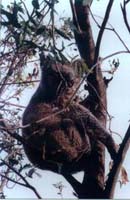
Alot more work is desperately required in the Strzelecki Ranges in regards to monitoring the Strzelecki Koala. In terms of a methodology the following strategy from the south coast of New South Wales may be of use;
"...The only method of site assessment for modelling purposes that has been peer reviewed and published in the literature is in Phillips (2000a&b). The data collected using this method formed the basis of the tree species preferences list provided to the NSW Koala Recovery Team in Phillips (2000). This formed the basis upon which management area boundaries for regionally-based koala recovery programs were developed.
The current IFAO (Integrated Forestry Operations Approval) method for data collection has not been peer-reviewed and is not compatible with the method used above (Phillips pers. comm.). It should be replaced with the method that is.
Assessment of breeding potential at active sites
A key question that has to be addressed by surveys in every case where evidence of koalas is found is whether the area is being used by a dispersing animal or breeding association, or one that has the potential to breed.
This can be assessed if the follow-up surveys address the following questions:
1. Are there koala faecal pellets of consistently different sizes at any active sites?
2. Are there two of more males bellowing in the general vicinity, particularly during the breeding season?
3. Do genetic tests of koala faecal pellets reveal that more than one animal is present?
If the answer to any of the above is positive then it should be assumed that there is at least a potential breeding association in the area.
In order to answer the above questions the following surveys will be essential:
1. Repeated unobstrusive visits at night to the survey area during the breeding season to listed for koalas bellowing (or alternatively automatic recording stations that are triggered by the sound of a bellowing koala).
2. Playback at the end of the breeding season.
3. Repeated sweep surveys over a much wider area than just the proposed logging coupe for at least a 12 month period. .
Previous advice by independent scientists
In his report to the NPWS Martin (1992) stated, "the various protocols directed at conserving koalas in the Eden Management Area are of little use until they are firmly based on a knowledge of this population".
In his report in 1993 to the NPWS and SFNSW Cork (1995) advised that the protocols were: "too subjective and unquantified to be applied in areas of high importance for Koala conservation."
Protocol details
Nevertheless the IFOA has enabled the implementation of protocols that are little different from those criticized by two of the most experienced koala scientists in Australia. Those logging protocols require the following in koala areas:
1. small (50m) protection zones around specific trees under which koala faecal pellets are located.
2. narrow corridors (40m wide) to retained or less recently logged areas;
3. 10 "browse" trees to be retained per hectare within the net logging area of any compartments where evidence of koalas is found; and
4. 150 ha of suitable habitat for koalas to be retained within 1.5 km of the trees identified with koala evidence."
Source: National Parks Association Far South Coast Branch - Submission on IFOA Survey and Logging Protocols for Koalas in the Eden Region. Main Author: Chris Allen.
"FROM OUR CALCULATIONS, TO GRANT 150 HA OF SUITABLE HABITAT FOR KOALAS SITED SINCE 1990 WITHIN THE MOUNTAIN ASH REFORESTATION IN THE STRZELECKI RANGES, A TOTAL OF APPROXIMATELY 12,960 HECTARES WOULD NEED TO BE SET ASIDE. THIS WOULD REPRESENT APPROXIMATELY 70% OF THE HARDWOOD REFORESTATION/PLANTATION OF THE STRZELECKIS ESTABLISHED UP TO 1992 BY THE STATE GOVERNMENT AND AUSTRALIAN PAPER MANUFACTUERS." Friends of the Earth Melbourne.
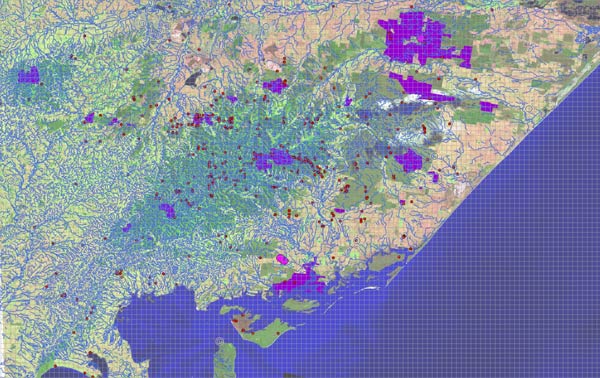
Koalas sitings (in red) in relation to Reserves (purple) in the Strzelecki Ranges and Central/South Gippsland - Nooramunga Marine Reserve not included on this map. Note also known translocation sites (Pink circles). As the map indicates most koala sitings since 1990 have occurred outside of Reserves. The Strzelecki Ranges has the smallest reserved area of a bioregion in Victoria at 2%. The highest concentrations are throughout the Strzelecki Ranges and Mullungdung/Wonwron State Forest.
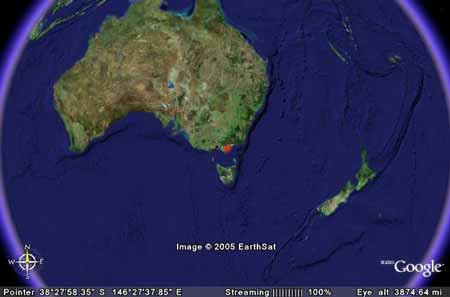
Australia from space. Strzeleckis marked by red dot.

Approximate location of the Strzelecki Ranges in relation to Melbourne, the capital city of Victoria.
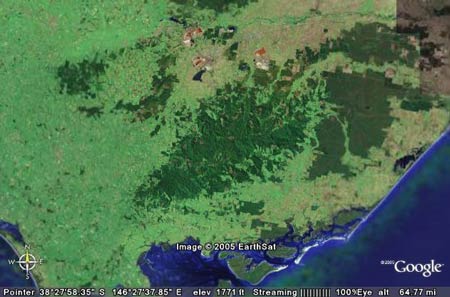
Strzelecki Ranges, with Mullungdung and Wonwron Forests at right of screen.
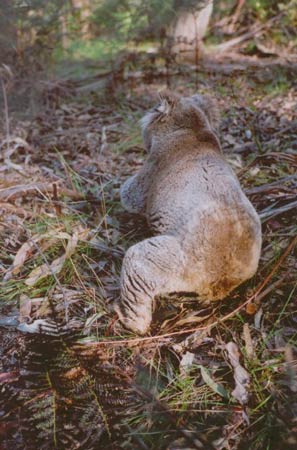
"Koala" is an Aboriginal word rumoured to mean "no drink". The koala usually does not drink water but gets sufficient moisture from the gum leaves on which it feeds and from dew. It lives in gum trees, mostly sleeping by day and moving about on the ground at night, often travelling considerable distances.
The koala is a marsupial, that is, it has a pouch in which to carry its young and it is unique to Australia. The newly born koala is under-developed, measuring less than 2 cm length and weighing a few grams. It finds its way to its mother's pouch where it is suckled for about six months. By this time it is well furred and has grown to about 20cm in length.
For a further two months, the baby koala continues to live in the pouch, but enters and leaves it at will. After this the parent carries the young one on its back until it is about one year old. The young koala is mature after four years and can live as long as 15 years.
Koalas usually produce one baby each year. The mating period is between September and January and the gestation period is about five weeks. The male koala has more than one mate but the female lives alone while caring for its young.
The koala has been protected by law since 1898 and penalties for shooting are severe. Koalas found in Queensland and New South Wales differ from those commonly seen in Victoria. The northern koalas are smaller with tawny fur and those found in Victoria are more robust and have dark grey shaggy coats. Until the beginning of the twentieth century koalas were common in Victoria, but their numbers were heavily reduced by disease and indiscriminate shooting.
An adult male koala weighs about 10 kgs and the female about 9 kgs. The squat body is thickly furred and dark grey to brown in colour. It has a rudimentary tail. As a result of so much sitting on the branches of trees, the rump of the koala is thick and course. Conspicuous features are the large black nose, large fur-covered ears and brown eyes. The koala has muscular limbs with large curved claws for climbing. Normally harmless and friendly, the koala will bite and claw fiercely if handled roughly and frightened. Slow to move, they are frequently trapped and destroyed in bush fires, apparently unable to anticipate danger in time to reach safety.
Food of the koala consists of leaves, buds and twigs of certain types of gum trees and small quantities of earth, presumably to add minerals to its diet. The adult will consume about 1 kg of gum leaves a day. Koalas can overbrowse trees, but generally do not damage the trees in which they live (unless there is an overpopulation problem). They can climb easily and jump from branch to branch. On the ground the koala has clumsy movements in contrast to its climbing agility. Relatively defenseless, its slowness on the ground makes it an easy prey to dogs and foxes.
Some studies have shown that koalas establish stable breeding aggregations, by arranging themselves in a matrix of overlapping home range areas (Lee and Martin 1988). The home range vary in size and are dependent on quality of the habitat and the sex of the animal, with males tending to have larger home ranges than females. Adult Koalas in a stable population may keep to the approximate same locations for several years. Repeated use of certain trees is also a tendency of koalas. These same trees may in turn also be used by other Koalas in the population.
Historical disturbances of Koala habitat either through urban development, farming, logging, mining and fire, may lead to lower activity levels being recorded, however if Koala food trees are present and Koalas are known to occur in the general area, then these lower activity locations should not be regarded as less important. Indeed some studies have shown that some low density Koala populations are the result of the absence of primary food trees, with the Koalas surviving on "secondary" species only.
Although hunted to almost extinction up to the 1930's, koala populations in Victoria, have recovered to a large extent. However, on a national level, Koalas have been listed nationally as a threatened species by the U.S. Fish and Wildlife Service (USFWS) in 2000. "Estimates of the size of the national koala population vary from under 100,000 (Australian Koala Foundation 1994) to media accounts quoting scientists saying that there are as many as one million animals in Victoria alone" (Phillips 2000). Loss of key food trees is probably the biggest threat to koalas, including the likelihood of overbrowsing and over population in some translocated populations in Victoria. "The effect of stochastic events such as wildfire on koala populations remains largely anecdotal (e.g., Lee & Martin 1988; Phillips 1990; Smith & Smith 1990). Starr (1990), however, described the loss of an entire koala population in a fire near Port Macquarie on the northern coast of New South Wales . . . In urban and semi-rural areas, significant mortality from motor vehicles and feral and domestic dogs (Backhouse & Crouch 1990; Canfield 1990a; Smith & Smith 1990; Starr 1990; Nattrass & Fielder 1996) severely limits the ability of populations to recover from stochastic processes such as fire". (Phillips 2000 Population Trends and the Koala Conservation Debate AKF 2000).
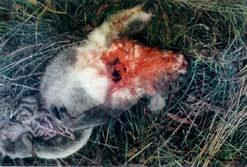
"Knowledge about the reproductive potential of koala populations has come largely from studies in Victoria. Martin and Handasyde (1990a, 1990b) reported rates of increase (r) and population doubling times (PDTs) that varied from 0.06 (11.8-12.2) years for the Chlamydia-positive Raymond Island population to 0.19 (3.6 years) and 0.21-0.26 (2.7 - 3.3 years) for the Chlamydia-negative populations of Quail Island and Sandy Point respectively . . . such results support notions about the potential of some koala populations to increase rapidly. In contrast, there are few quantitative data on the r values of declining populations". (Phillips 2000 Population Trends and the Koala Conservation Debate AKF 2000).
"...Assuming that food resources were limiting, this result, coupled with that for the Barrenjoey population for 1955-1972 ... suggests a capacity for koala populations to maintain stable levels in the absence of undue disturbance. In 1976, however about 30 animals of various demographic cohorts were translocated some 100 km away (Gall 1978). From 1977 to 1990 the finite rate of increase for the Tucki population ... suggested a population halving time of 4.56 - 19.25 years ... Given that the Tucki area has been the focus of intense community interest and ongoing habitat regeneration projects since the 1950s (Gall 1978, 1980; New South Wales National Parks and Wildlife Service, unpublished data), habitat loss and fire can be effectively ruled out as reasons for the decline..." (Phillips 2000 Population Trends and the Koala Conservation Debate AKF 2000).
"Unlike that of the Tucki population, the history of koalas at Mt Macedon, Victoria, is less well known. There are records of introductions dating from 1923 as part of the Victorian government's translocation program, including 41 animals from French Island in 1987 and 27 animals from Sandy Point in 1991 (Emmins 1996a). Despite these introductions, the finite rate of increase for the Mt Macedon population from 1970 to 1997 is r = -0.063 ... a population halving time of 8.77 - 14.75 years". (Phillips 2000 Population Trends and the Koala Conservation Debate AKF 2000).
"... In the case of Mt Macedon, the data indicated a decline in population size of 68% over the three-generation period 1972 -1990. The Tucki data show a 73% decline from 1977-1990. Although less robust, the Barrenjoey data suggest a decline of 93% over the period 1972 -1988. Declines of this magnitude are not uniform throughout the remaining range of the koala, but they are widespread. Lunney et al. (1993) reported localized extinctions over 16-20 years in the Coffs Harbour area of New South Wales. The population of Oakey, Queensland, reported by Gordon et al. (1990) decreased by 54% over the 12-year period of their study, and counts on Phillip Island, by Backhouse and Crouch (1990) indicate a decline of nearly 90% from 1973 to 1988. Declines have also been documented for Kuringai Chase, New South Wales (Smith & Smith 1990), southeastern New South Wales (Lunney et al. 1997), and the Grampians, Victoria (Martin & Handasyde 1990a). (Phillips 2000 Population Trends and the Koala Conservation Debate AKF 2000).
"... One possible reason that applications for national listing have been unsuccessful is that a number of koala populations in Victoria and South Australia have increased recently, and some scientists believe that declines elsewhere do not yet threaten the species overall . . . In terms of requirements for a robust decision-making process (Stratford et al.), this lack of attention to detail represents a serious lapse of standards which, when combined with uncertainty about contemporary population trends, must be addressed in future conservation assessments, legislation, and policies regarding koalas. (Phillips 2000 Population Trends and the Koala Conservation Debate AKF 2000).
"By applying standards to information and using caution in addressing disagreement and uncertainty about population trends a conservative conclusion that the category of highest risk applicable to the koala throughout most of its remaining range is that of vulnerable (in accordance with IUCN criteria) must be considered. Given the rate of habitat loss and fragmentation in eastern Australia and the time periods of contemporary population declines, a pessimistic forecaster might suggest that there is a real risk of koalas becoming endangered in the next 10-15 years. The next and most important steps are (1) to acknowledge the legitimacy of different opinions while critically assessing the assumptions and data on which they are based and (2) to accept and work with the uncertainty in a precautionary way as recommended by the IUCN" (Phillips 2000 Population Trends and the Koala Conservation Debate AKF 2000).

The Koala is the only living member of its family, Phascolarctidae. "This is an ancient family that reached maximum diversity in the Oligocene Epoch (34-24 million years ago). Six genera and 18 fossil species have been described (Black 1999) but only one species remains - the Koala Phascolarctos cinereus". Victoria's Koala Management Strategy 2004.
"The Koala was not seen in 1770 by Captain Cook's party at Botany Bay because of its forest preference, and it went unreported for a decade after settlement. The earliest report was made by John Price, a young free servant of the Governor, Captain John Hunter, in the account if his journey in 1798 into the tablelands west of Sydney. . .
Unlike most of the early discoveries, the peculiar animal was not given a scientific name till 1816. Then, though the only specimens were in England, it was the French naturalist de Blainville who provided the generic name Phascolarctos, from the Greek meaning a leather bag (pouch) and a bear. The German naturalist Goldfuss gave the specific name cinereus because of the ashy-grey colouring of the original specimens, from west of the Nepean River, near Sydney. . .
In spite of such sustained interest, no report of the Victorian koala was generally known until my collegue G.P. Whitley discovered the first published reference in the Transactions of the Philosophical Society of Victoria for 1855 (vol, i, p.68). There the prominent explorer William Blandowski gave an account, and the aboriginal name "Karbor" by which it was known in the Murray River region. . .
As it became evident from Australian museum specimens that the Victorian koala was even more distinguishable by its robust build and sparser rather shaggy coat, more uniformly brown above, a southern race (P.cinereus victor) was described by the author in 1935" (Furred Animals of Australia Ellis Troughton 1945?)
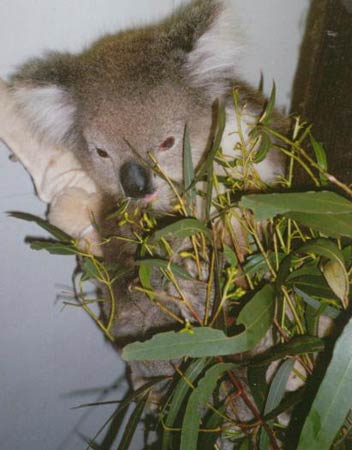

"Within 100 years of European settlement of the continent, the koala was almost extinct. Logging and clearing for farms had wiped out much of the tree-climbing marsupial's habitat and food supply, resulting in a massive drop in the population - but worse, in the guise of trappers was to come.
For the equivalent of 50 cents per pelt, these men began shooting. In 1919 they killed one million koalas, in 1924 they shot two million. Then, on August 1, 1927, open season was declared on koalas for a period of 30 days. In that short time 600,000 adults died. Some 200,000 baby koalas were left to starve to death. The Queensland Government actively participated in this holocaust, reaping a bounty for every animal killed.
But eventually Australian and world outcry resulted in U.S. President Herbert Hoover banning the import of koala skins. By then 90 per cent if the world's most loveable marsupial had been destroyed." Source: Could YOU kill a koala? By Gary Tippet Sun 24/10/78.
The Koala on Wilson's Promontory by Jas. A. Kershaw, C.M.Z.S. The Victorian Naturalist Vol 51, July 1934 ...
"Wilson's Promontory has long been regarded as the home of the Koala. Totally unsettled, densely timbered and, until recent years, rarely visited except by cattle musterers, this area has always been an ideal sanctuary. Thirty years ago the Koala was fairly numerous in spite of the periodical raids of skin-hunters.
According to statements made by old residents on the mainland, parties had been in the habit of visiting the Promontory every winter to obtain skins of both Koalas and wallabies and, as a consequence, large numbers of these animals were destroyed....
Following the permanent reservation of the Promontory in 1908 as a National Park and Sanctuary for the preservation of the native fauna and flora, these interesting animals were no longer molested, but were permitted to enjoy unrestricted freedom in their natural home. As a result Koalas gradually increased in numbers and in the course of a few years became so numerous that, in favourable situations, one could always rely on seeing from thirty to forty in a comparitively small area. Their immunity from interference of any kind, extending over a number of years, together with their natural increase, resulted in their multiplying to such an extent as seriously to threaten the existence of their natural food plant.
In the extensive valley at Oberon Bay and in one or two other localities favoured by the Koalas, it was noticed that quite a number of the trees had died, and investigation proved that this was due to repeated defoliation by these animals. Action was at once taken to reduce their numbers. Where it was possible, many were transferred to other parts of the Park, but in remote localities, such as Oberon Bay, transport was out of the question so that it became necessary, in order to save the remaining trees, to have a number destroyed. This had the desired effect for a time, but as the trees, in their effort to recover, sprouted new leaves, the Koalas returned and again stripped them, with the result that, in certain localities, this particular Eucalypt was practically exterminated.
Their food-plant gone, many of the animals died, others worked back into the more heavily timbered ranges of the interior where they found suitable food among the Blue Gums. With a view to their acclimatization in some of the other States several Koalas were forwarded to New South Wales, South Australia, and Western Australia. Native bears are still fairly numerous in the timbered country on the northern and eastern coasts of the Promontory and among the big timber in the vicinity of Sealer's Cove; and with the replanting of the depleted areas thay will no doubt return to their former haunts".
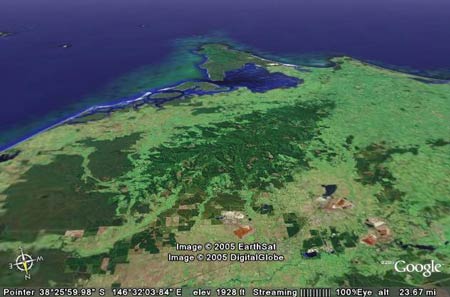
Koalas in the Gippsland Hills - Victorian Naturalist Vol. 68 August 1951
"Although so much of the original forest has been entirely destroyed on the ranges that lie south from Morwell, we still see an occasional "native bear", perhaps half a dozen of them during the course of the year. They evidently travel quite a distance across country between known food trees, usually during hours of darkness, but we have met with them on the ground during the day, too. Manna Gums do grow along the upper reaches of the Morwell River, but koalas seem to favour the local form of bluegum (euc. Bicostata), which was once the principal timber of many of the hill spurs.
In earlier days Bluegum country rates highly with selectors, and to-day there remain only comparitively few trees, mostly young ones in inaccessible places. On our farm at Budgeree stood one stunted bushy Bluegum, at the head of a gully. It always had a "moth-eaten" appearance and was seldom well clothed with leaves. The reason, we found, was a visiting koala which would appear in the tree one morning and stay until the food supply ran short, which might be several weeks. It would then depart, as unobtrusively as it came. There were no trees of the same kind for at least half a mile in any direction. No sooner had a nice fresh crop of foliage grown again than a large furry ball would be noticied sleeping in one of the highest forks. We supposed that bear had a regular round which kept it busy during throughout the year - when the last tree was eaten out, the first one would have freshened up once more.
There can be no doubt that fire has been, and still is, the great enemy of koalas. There are still fairly large areas of Messmate-Peppermint bush, with a sprinkling of several other eucalypts, on the northern slopes of the hills. Much of it is privately owned and subject to severe burning off at intervals. Pulp cutters take only the best part of the tree trunks and leave a welter of limbs and leaves, ripe for burning, amongst thickets of acacia and dogwood which are themselves the aftermath of earlier fires Ground-dwelling animals and even lyrebirds can run before a slow-burning fire front, but the unfortunate tree-dwellers mush perish miserably. It would seem that the planting of Bluegums on a large scale in the hills (they are fast growers on their native heath) would attract and maintain the remaining koala population and arrest the decline of their numbers in this part, at least, of Victoria". E. Lyndon, Yinnar
The Rehabiltation of the Koala in Victoria By F.Lewis The Victorian Naturalist Vol.70 March 1954
"... In the early 1920s, when in charge of the department (Fisheries and Game), I became very concerned at the state of affairs. Inquiries were instituted to determine where and in what numbers koalas still existed. It appeared that they had gone entirely from Western Victoria, the Goulburn Valley and the north-east, and that only in a few places in Gippsland did any remain.
To ascertain the exact position, I investigated Gippsland from Dandenong to Yarram, all through the hill country of the Strzelecki Ranges where once these animals lived in their thousands. Schools were visited and scholars questioned as to how many had seen koalas; milk and cream carters were interviewed, in fact anyone who had knowledge of the country was sought.
The net result was that, although an odd few animals were found, it was definately proved that only two small colonies existed, one near Yarram and the other between Grantville and Corinella.
Investigation of the three islands in Western Port was then undertaken. As already stated, koalas were not indigenous to any of these. It appears that a few were first taken to Phillip Island in 1870 by a Mr J.F.Smith, from the Bass River. Later, Mr W.Kennon obtained some from Flinders, and Mr Graden some from Gippsland; but it was not until many years later, when Mr W. Thompson of Cowes brought a good many from French Island, that the population really began to increase. As regards French Island, some fishermen of Corinella informed me that they took the first koalas there in the 1880's. They did not increase to any great extent, however for many years..."
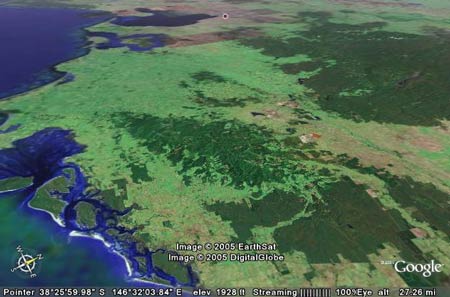
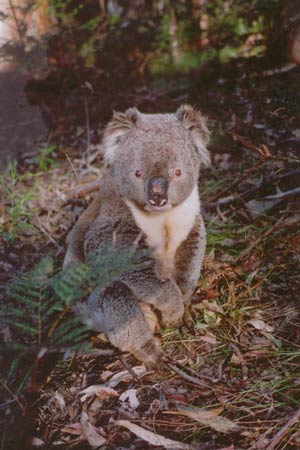
"Island populations began with only a small subset of the genetic variation that was present in Victorian Koalas in the 1890s. Each time Koalas were captured for relocation, this small subsample of genetic variation was further subsampled. As the translocation program has been so widespread, any remnant populations of Koalas have probably had their original gene pool swamped by the restricted gene pool of the island animals. Recent studies of variation in mt DNA across the Koala's range has supported this scenario. The same haplotype is present in most Victorian and Kangaroo Island populations. South Gippsland and Strzelecki Range Koalas have two extra haplotypes - one shared (H7) and a unique third haplotype each. The Strzelecki and South Gippsland populations thus form a seperate management unit within Victoria and have been treated this way since 1989". ANHM Presentation: Managing Victoria's Koalas by Peter Menkhorst.
An investigation carried out by Dr Bronwyn Houlden, School of Biological Science, University of New South Wales, 20th March 1997 and 6th April 1998 confirmed that the genetic pool of South Gippsland koalas has not been compromised. Dr Houlden indicated that on a national basis koalas generally are not considered to be threatened. She advised that this assessment has unfortunately led to an extremely simplistic view of conservation of biodiversity in the species. Her report was entitled "Low genetic variability of the koala Phascolarctos cinereus in south-eastern Australia following a severe population bottleneck" - Published in Molecular Ecology 1996, 5 269-281.
Through extensive analysis by herself and her collaborators Houlden revealed that the species is composed of highly differentiated populations with low levels of gene flow between populations throughout their range. The Strzelecki Koala population constitutes a separate management unit and is significant in terms of management of biodiversity on a regional and state basis. Dr Houlden found that the Strzelecki Ranges had the highest level of genetic variation, of any Victorian population she analysed. This is important, given the low levels of genetic variability found in many populations in Victoria, which have been involved in the translocation program.
"p278 The S. Gippsland area was known to have suffered the least severe bottleneck of any population from the south-eastern region, because a remnant population of some magnitude was present at the end of the fur trade. . . The S.Gippsland populations may have been of sufficient size to have minimized the initial loss of rare alleles (Fuerst & Maryama 1986) that occurred in bottlenecks suffered by other south-east Australian populations, and/or to have expanded rapidly afterwards, thus preventing further loss. However, the levels of allelic diversity present in the population are consistent with suffering some adverse effects associated with being a small, isolated population for some time." Low genetic variability of the koala Phascolarctos cinereus in south-eastern Australia following a severe population bottleneck" - Published in Molecular Ecology 1996, 5 269-281.
The Strzelecki koala population has high levels of genetic variability which have been detected by rare and unique genetic markers. These animals are statistically significantly differentiated from other Australian populations and therefore constitute a separate management unit. Because biodiversity in the species as a whole is dependent of conservation of populations throughout the species range, the Strzelecki Ranges population, together with the South Gippsland population is nationally significant as well. The lack of genetic diversity amongst Australian koalas could be critical to the survival of the species as a whole.
"My results suggest that the conservation of South Gippsland and Strzelecki Ranges population is of local, State and National significance for conservation of biodiversity in koalas, and managers and landholders should ensure that enough habitat is protected and/or available for the populations to maintain an effective population size that is viable." Dr Bronwyn Houlden.
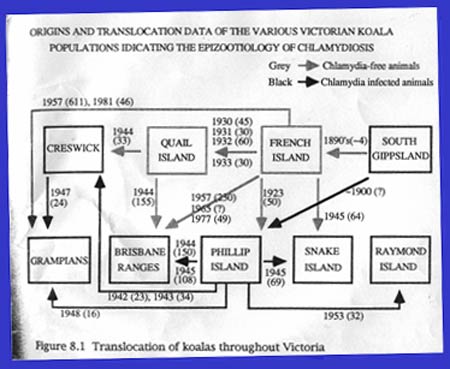
Diagram Source: p207 Emmins, John Jeffrey (The Victorian Koala (manuscript): Genetic Heterogeneity, Immune Responsiveness & Epizootiology of Chlarydiosis 1996 Thesis (PhD)-Monash University.
According to Houlden; "... Following a near-extinction bottleneck in the 1920s, mainland Victorian and Kangaroo Is. koalas have been involved in an extensive program of relocations. The source populations of the relocated animals were islands in Westernport Bay, which were founded by very few individuals in the late 1800s and early 1900s. The significantly lower levels of variation between south-eastern Australian populations suggests that human intervention has had a severe effect on levels of genetic diversity in this region, and this may have long-term genetic consequences".
Houldens' results were also echoed in a similar important study published in 1996. According to John Emmins in his 1996 (PhD) Thesis entitled; "The Victorian Koala (manuscript): Genetic Heterogeneity, Immune Responsiveness & Epizootiology of Charydiosis;
p282 "Having established that the system clearly detects similarities and differences in the genetic composition of populations the next important analysis was to examine the genetic diversity of the South Gippsland population. To reiterate, South Gippsland is reputably the "relic" ancestral population of Victorian koalas, which has not been subjected to a known genetic bottleneck. Without such an analysis, it cannot be assumed that this population is outbred.
As described in the literature review the cheetah proved to be so inbred that there is virtually no detectable genetic differences between individuals. This is probably due to a severe genetic bottleneck some time in its history (without this decline and recovery numbers having been noticed, recorded or passed down in written or oral history). This could easily have been the case with South Gippsland if for example that population had been reduced to a very small number of animals through the hunting and fire setting activities of aboriginals before European colonisation.
It is immediately obvious in South Gippsland DNA profiles that there is great genetic variability in this population... The table of D values ... and the statistical analysis of the D values derived from comparisons within that population show a mean D value of 0.48 which indicates that the South Gippsland koala population is more outbred than any other study population. This was an exciting finding and indicates the importance of this population as a rich gene pool for Victorian koalas." Emmins, John Jeffrey (The Victorian Koala (manuscript): Genetic Heterogeneity, Immune Responsiveness & Epizootiology of Chlarydiosis 1996 Thesis (PhD)-Monash University.
p285 "... The most important conclusions to be drawn from the genetic study are:
1 French Island koalas are an inbred population, and their lack of genetic diversity is consistent with them having gone through a severe genetic bottleneck implicit with the colony having been established from only a few animals approximately 100 years ago.
2 The colonies (located throughout South Eastern Australia) which have been set up largely from French Island descendants during the 70 years of translocations also have limited genetic diversity. Their gene pool may be somewhat larger however due to being additional translocations of koalas from Phillip Island which presumably did not go through as severe a bottleneck as French Island animals, (or at least were derived from different individuals). The exception to this are populations set up from French Island animals without additions from Phillip Island or elsewhere. Kangaroo Island (S.A.) demonstrates very clearly with the resident koala population appearing as inbred as laboratory rats with the only detectible genetic differences in the population being attributable to sex differences. (Shimmin et al, 1995 showed the mean D-value of laboratory rat strains to be very close to 1.0)
3 The Victorian koala is genetically quite different from New South Wales and Queensland koalas.
4 The Gold Coast koalas are as inbred as French Island koalas and therefore may also be derived from a limited number of individuals.
5 The South Gippsland koala population is the most outbred and genetically diverse of all the populations studied".
p286 "These findings have very significant repercussions in the management of the Victorian koala. They also show that the relic South Gippsland koala population is of great genetic importance and that this population (and its habitat) should be conserved at all costs to maintain a large gene pool. The genetic make-up of the remainder of Victoria's koalas is lacking in this diversity and needs to be addressed". Emmins, John Jeffrey (The Victorian Koala (manuscript): Genetic Heterogeneity, Immune Responsiveness & Epizootiology of Chlarydiosis 1996 Thesis (PhD)-Monash University.
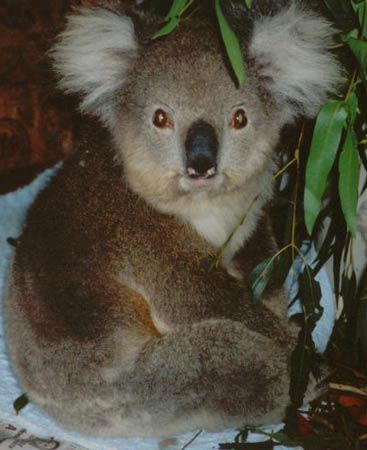
The Federal Government, through the National Koala Conservation Strategy (NKCS), has the aim of conserving Koalas by retaining viable populations throughout their natural range. To develop a better understanding of the conservation biology of Koalas, Objective 3 of the NKCS further recognises the need for development of a consistent and repeatable approach to assessment of Koala populations, in addition to surveys to establish correlates of habitat quality at both broad geographic scales and the individual tree-scale within preferred habitats (ANZECC 1998).
The koala was today listed under the US Endangered Species Act as threatened across its entire range.
The listing is the culmination of nine years intensive research and scientific submissions to the US Government by the Byron based Australians for Animals Inc. and the US based Fund for Animals.
Ms Arnold, Co-ordinator of Australians for Animals said:- " This is the second time in history that the US Government has moved to save the koala.
" The Australian State and Federal Governments are to be condemned for their total and explicit failure to protect our unique wildlife heritage. Although my group is delighted with this victory, it may well be a pyrrhic one for koalas unless the destruction of native forests by the timber industry is brought to an immediate halt. '
" Scientists who supervised the three extensive scientific submissions we presented to the US Government were quite specific in their affidavits as to the threats to koalas represented by the timber industry."
Dr Frank Carrick, University of Queensland said: " The koala is almost extinct in the Southern half of NSW. Even these survivors continue to be threatened by intensive forestry operations such as clearfelling of the Southern NSW forests for woodchip exports.
" Koalas in the Northern part of NSW - face the twin impacts of loss of habitat to residential development for a rapidly expanding human population and unsustainable use of the remaining forests. Away from the coast, the most substantial western populations of koalas in NSW are facing increasing threats from more intensive exploitation of the remaining forests."
Professor Tony Norton of RMIT, Melbourne, said in his affidavit: ' In my opinion, a number of populations across the species' range, particularly in NSW and Victoria, could become extinct before the end of the century if identified threatening processes such as habitat clearance and modification are not adequately controlled."
Australians for Animals has presented detailed evidence to the US Government of the massive tree clearing in Queensland which continues in that state. This clearing has had a disastrous effect on remaining koala habitat there. Ms Arnold said: - ' The final straw to koalas is the destruction of native forests authorised by state and federal governments under the Regional Forest Agreements.
" I say to Minister Robert Hill in response to his press release re:koalas ' In your dreams Robert ' "To dismiss the sheer extent of scientific evidence presented to the US Government when he knows full well that the basis of listing under the Endangered Species Act (US) relies entirely on science is scandalous. " The continued refusal of the State and Federal governments to protect koalas and their habitat is a global disgrace and only continues to underline the appalling international environmental record that the
Howard Government has earned. " With the Olympic Games just months away, the world focus will now betrained on Australia and its unique wildlife. The lack of protection for the gentle koala will disgust many people."
For further information:
Call Sue Arnold, Co ordinator, AFA 61 2 6684 3769 mobile : 0427 257 491
Dr Frank Carrick, Uni of Queensland phone:61 7 3365 2466
Professor Tony Norton, RMIT, 61 3 9925 3279
AUSTRALIANS FOR ANIMALS.P.O. Box 673, BYRON BAY NSW 2481
Phone: 61 2 6684 3769Fax: 61 2 6684 3768
Email: arnolds@mullum.com.au
http://www.australiansforanimals.org.au
Reg. Charity No. CFN 12644
Latrobe City is stepping up its campaign to lobby the federal and state governments to declare the Strzelecki or Gippsland Koalas an endangered species. Council wants to prevent what Friends of the Gippsland Bush alleges is the continued landclearing of the koala's habitat.
The koalas believed to be one of the few pure bred species of fauna left in Australia, have been declared an endangered species by the United States Government, but they have yet to receive the same status from the Australian Government. Government officials hit out at the US earlier this month over the move, describing it as scaremongering and irresponsible.
Minister for the Environment Robert Hill accused his US counterparts of ignoring conservation and wildlife management plans already in place as well as statistics on koala numbers. However Latrobe City Mayor Tony Hanning said both state and federal governments needed to take responsibility for the protection of the genetically and geographically unique koalas.
The protection of the koalas forms part of Latrobe City's bio-diversity conservation policy contained in the environmental planning scheme, released in March this year. "Local government is not powerless, we're empowered under state legislation to protect native vegetation," Cr Hanning said. "But we can't do it alone, we need state and federal intervention, although both state and federal governments could not stand up and claim to be environmental to any degree."
Negotiations between the city and Hancock Victorian Plantations are now into their sixth month over a December recommendation by council to lobby the company to "encourage and promote a sustainable timber industry", a key plank in ensuring the survival of the Gippsland Koala according to Cr Hanning.
Friends of the Gippsland Bush secretary Suzie Zent said the exclusion of the Strzelecki Ranges on the recently finalised Regional Forestry Agreement had left the future of the koalas under threat. "There is no effective mechanism of legislation in Victoria which protects our unique koala," she said. "The majority of the Strzelecki Koalas are on private property, the bulk of which is owned by Australian Paper Plantations (Amcor) and Hancock. "We believe these koalas are the last remaining endemic species in Victoria and probably Australia."
However, in a metropolitan newspaper report earlier this month, Hancock Victorian Plantations chief executive officer Kevin White claimed 18,000 hectares of forest had been set aside from logging pending a joint community groups biodiversity study.
That claim met a cool response from Australians for Animals co-ordinator Sue Arnold, who said conservation organisation Friends of the Earth had confirmed the koala's habitat was under threat. She described the current land clearing as a "national tragedy", adding the koalas were like "precious museum pieces; if we had a living museum, these koalas would be part of it".
"The issue isn't the number of koalas, it's the habitat and without their habitat, the koalas will die", she said. "Koalas are uniquely adapted to local ecosystems. They can't move on and take a holiday into other parts of Victoria. They die without their trees. Once you start to clear, the forest becomes sick. Koalas get stressed if their trees go and that stress can kill them".
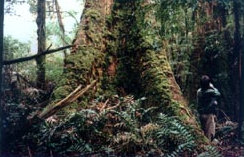
The Victorian State Government has also acknowledged the importance of the Strzelecki and South Gippsland Koalas through their 2004 Victoria's Koala Management Strategy;
p13 "Issue 4 Managing Genetic Structure
Victoria's Koalas have a most unusual genetic history. Koala populations in Victoria declined drastically during the early 1900s. By the 1930s, the Koala on the Victorian mainland was thought to be confined to a few remnant populations in South Gippsland and the Mornington Peninsula (Lewis 1954). Fortunately, local people had introduced a few koalas to French Island and Phillip Island in Western Port during the 1890s and early 1900s. The descendants of these animals have since been used to restock unoccupied habitat across Victoria in one of the largest and most successful wildlife reintroduction programs ever undertaken.
Unfortunately, the stock used to found the French Island population in about 1898 probably comprised only a few animals, thereby creating a severe genetic bottleneck. The founders for the Phillip Island population were more numerous and from a greater geographic range, but never-the-less also represent a significant genetic bottleneck. An unforseen consequence of using these populations to restock the Victorian mainland is likely to have been the genetic swamping of any remnant populations by the restricted and in-bred island gene pool. Thus, the level of genetic variation in Victorian Koala populations is significantly lower than that found across comparable areas in NSW and Qld (Houlden, et al. 1996, 1999). It is also lower than in several species of endangered marsupial including the Bilby, Bridled Nailtail Wallaby and Queensland populations of Yellow-footed Rock Wallaby, but is higher than in the two species of hairy-nosed wombat (Bower, et al. 2002). Therefore, there is a higher threat of inbreeding depression in Victorian Koala populations than in Koala populations further north.
Although genetic theory predicts that populations with low genetic variation will have lower survival prospects, there is currently no evidence that the population growth potential of Victorian Koalas is being constrained by their genetic history. On the contrary, many populations derived from island stock are flourishing. However, given the finding that a higher than normal proportion of male Koalas on French Island exhibit testicular aplasia (Seymour, et al. 2001), it would be prudent to be alert to signs of inbreeding depression in Victorian Koalas (Sherwin, et al. 2000).
Only in South Gippsland does it appear that some remnants of the original gene pool survive, thanks to a strong remnant population and few releases of island stock. However, current information on the geographic spread of Koalas with this higher genetic variation is poor. Further, very little Koala habitat in South Gippsland is reserved for conservation purposes. Most is highly fragmented, and some is threatened by unsympathetic land uses. Therefore, if significant remnant genetic resources persist in South Gippsland it is imperative to ensure that habitat is protected as far as possible. It may also be prudent to spread the risk to the remnant South Gippsland population by establishing new populations, using founders from South Gippsland, in areas isolated from the effects of the re-introduction program. The Wonnangatta Valley has been suggested as one such locality (Martin 1989)".
p18 Issue 4 Managing genetic structure
Objective 7
To conserve the remnant genotype in South Gippsland Koalas, and to ensure that the low level of genetic variation in Koalas elsewhere in Victoria does not adversely affect the capacity of the species to survive and flourish in this state.
Lead Agent: DSE Biodiversity and Natural Resources Division in conjunction with an appropriate genetics research laboratory. Timeframe: medium to long term.
Action 17:
*Initiate a detailed survey of genetic diversity, using microsatellite and mitochondrial DNA markers, across South Gippsland, from Western Port to Sale and from the Princes Highway to Refuge Cove, Wilsons Promontory. Priority: High.
Action 18:
*Facilitate research into the relationship between the low genetic diversity of Victorian Koalas and population fitness. Priority: Medium.
Action 19:
*If surveys of genetic diversity in South Gippsland indicate that the remnant genotype is geographically restricted within that area, investigate the practicality and value of artificially disseminating the diverse genotype(s) more widely through the Victorian population. Priority: medium.
Action 20:
*Depending on the outcomes of Actions 16 and 18, investigate the suitability of the Wonnangatta Valley as Koala habitat. If it is deemed suitable, use Koalas from South Gippsland to establish a population there by translocation. Obtain advice from Koala geneticists on an appropriate number of founder animals, having regard for possible impacts on the source populations. Priority: Medium".
The forests of the Strzelecki Ranges have for the past 120 years had a very troubled past. Widespread clearing, logging and burning decimated large areas of the ranges in the late 19th century. Farms established in the region, especially in the eastern Strzeleckis were difficult to maintain as a result of steep slopes and difficult climate. Due to these factors many farmers walked off the land by the 1930's resulting in abondoned farmland scattered throughout the ranges. Some of this land naturally regenerated back to forest and scrub.
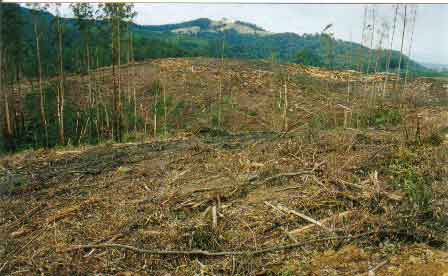
August 2002: Mutual Track, northern Strzelecki ranges, post logging.
In 1937 the Maryvale Pulp mill began operating. By the early 1950's Australian Paper Manufacturers began a widescale plantation program in the northern Strzeleckis and central Gippsland region on private land. A large amount of native vegetation was converted to pine plantations during this stage. In 1961 the State Government signed a Wood Pulp Agreement with APM that allowed APM to clear native forest and scrubland in the northern Strzeleckis to re-establish eucalypts for the pulp mill. In 1966 the Wood Pulp Agreement Act increased the areas to be converted to "plantations". Most of the plantings on this leasehold land occurred on the northern slopes of Middle Creek, Jeeralang Creek, Morwell River East Branch and Traralgon Creek. The plantings consisted almost all of the endemic Eucalyptus regnans (Mountain Ash) and Radiata Pine. The most recent version of the Wood Pulp Agreement was signed by the Kennett Government in 1996, granting all of the Strzeleckis and a large portion of the Central Highlands to the Amcor pulp and paper mill at Maryvale.
During the late 1940's the State Government also began to establish eucalypts on land that included cleared farmland and scrubland abondoned by farmers. Tiny amounts of Radiata pine were also established in the 1940s. Eucalypts started to be established in 1949. Widescale planting of pine in the Strzeleckis by the State Government did not commence until 1965. Widespread eucalypt plantings did not occur until 1961, the same time as the 1961 Wood Pulp Agreement. Pine plantings by the State Government continued until 1992 (peak years being 1977, 1988 and 1989). Eucalypt plantings continued until 1991, with the peak years being 1977, 1978 and 1979. It is Friends of the Earth's contention that these plantings occurred mainly to feed future demands of the Maryvale pulp mill. Therefore much lot of the Strzeleckis was converted hardwood reforestation. By 1992 the State Government alone had established 15,207.2 hectares of pine and 7,151.3 hectares of hardwood plantations. APM established a similar amount of eucalypt on its leasehold and private land and over 20,000 hectares of pine in the Strzelecki and Central Gippsland.
Not all the land in the region was converted to plantations. Significant areas of native vegetation were retained. Some areas were also too steep to log and these areas also avoided the chainsaw. Some remnant stands of regrowth forest and remnant old growth and cool temperate rainforest survived. These remnants were sometimes surrounded by the new eucalypt plantings. Over the following decades, as the eucalypt plantings matured, they began to resemble native forest. This is especially the case with the Mountain Ash plantings. In some areas the reforestation was so successful that people assumed that the replanted eucalypts were actually the original native forest. Indigenous understorey species also utilised these new plantings.
In 1993 the Kennett Government announced the formation of the Victorian Plantations Corporation. Under the VPC Act, the Corporation was granted logging rights to all of the state government Strzelecki plantings, including the non-planted remnant vegetation. The Act also allowed, through the Code of Forest Practices, the purchased land to be classed as private land. Environmental Compliance on private land is the responsibility of the local council. (Local shires with responsibility for Hancock land in Gippsland and the Strzeleckis include; LaTrobe, Wellington, South Gippsland and Baw Baw). Private land designations under the Code of Forest Practices are generally less prescriptive than those that occur in State Forests. VPC soon began targeting planted eucalypt areas and non planted areas infuriating the local community. Old growth forest was being logged in the region in 1996. Some of this forest included buffer zones of cool temperate rainforest.
By 1997 two forest groups had emerged to raise the profile of the region and the activities of the VPC. One group based on the southern slopes lobbied that all of the replanted estate should be turned into a National Park. Another group, Friends of Gippsland Bush, working on the northern slopes, actively sought to keep the logging to planted forests, whilst working vigorously to protect all remnant vegetation. Members of Friends of Gippsland Bush, Elaina Fraser and Susie Zent began mapping and walking the remnant stands of cool temperate rainforest and oldgrowth in the region in 1996. By 2001, almost 90% of the rainforest outside of reserves had effectively been walked and mapped.
In November 1998, the US based John Hancock Financial Services purchased the assets of VPC throughout the State of Victoria. The purchase included approximately 107,000 hectares of plantations throughout Victoria (93% pine, 7% strzelecki eucalypt) and 63,000 hectares native vegetation. Under the VPC Act, the company could effectively log the lot.
In 2000 Friends of the Earth established the Hancock Watch website as a means to network what Hancock was up to to a wider audience. One of the central arguments used on the website was the vital need to protect cool temperate rainforest and koala habitat in the Strzelecki Ranges. In August 2001, Hancock then purchased the private land assets of Australian Paper Plantations and the logging rights to the APM leasehold land in the northern Strzeleckis. This purchase effectively gave Hancock control of about 250,000 hectares of land throughout Victoria, with 100,000 hectares located in the Gippsland region. By August 2005, the Hancock Watch site had generated over 112,000 visits.
In 2001, a Strzelecki Working Group was established to look at issues of creating a reserve of the remnant cool temperate rainforest in the Strzeleckis. The group included representatives of local environment groups, local shires and Hancock. Biosis Pty Ltd was employed to do a desk top study of the region. A moratorium was supposedly set in place to keep logging out of key rainforest catchments, in areas nominated as the 'Cores and Links Reserve'.

Cadastral map of the Strzelecki Ranges - not including Reserves, indicating a) land vested under the control of the Victorian Plantations Corporation, b) land leased by Australian Paper Manufacturers under the 1961 and 1966 Wood Pulp Agreements, and c) private land established with trees by Australian Paper Manufacturers. All of the shaded land now comes under the control of Grand Ridge Plantations Pty Ltd, a subidiary of Hancock Natural Resource Group in turn owned by Boston based John Hancock Financial Services.

Cadastral map of the Strzelecki Ranges, indicating a) land vested under the control of the Victorian Plantations Corporation, b) land leased by Australian Paper Manufacturers under the 1961 and 1966 Wood Pulp Agreements, and c) private land established with trees by Australian Paper Manufacturers. All of the shaded land now comes under the control of Grand Ridge Plantations Pty Ltd, a subidiary of Hancock Natural Resource Group in turn owned by Boston based John Hancock Financial Services. Note most of Mullungdung and Wonwron forests still in public ownership.
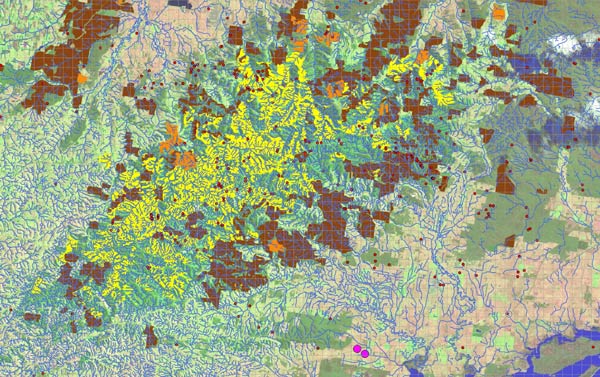
Strzelecki Forest including current land use. Yellow is Mt Ash, Brown is Radiata Pine and Orange is ex pine sites replanted with Shining Gum in past 2-3 years.
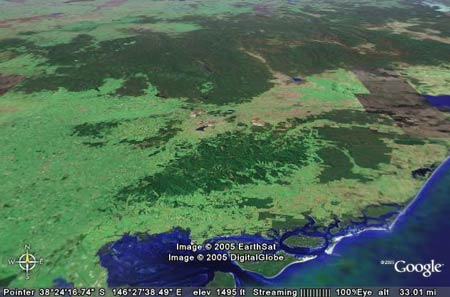
Strzelecki Ranges looking north.

Strzelecki Ranges looking south west.

Strzelecki Ranges looking south.